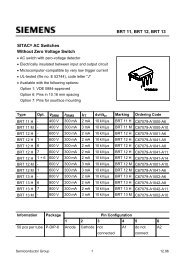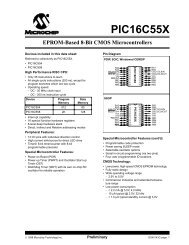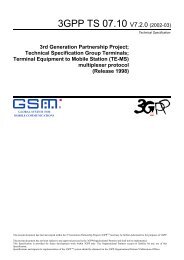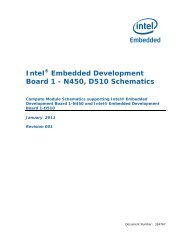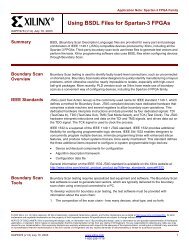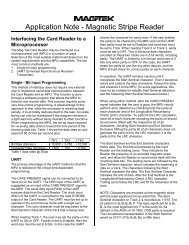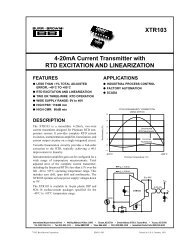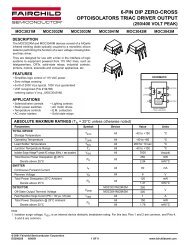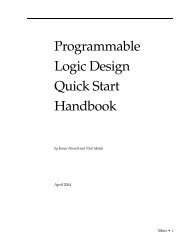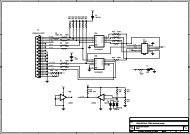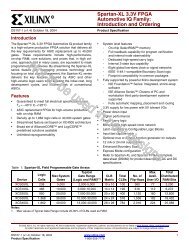Xilinx XAPP224 Data Recovery application note - Eetasia.com
Xilinx XAPP224 Data Recovery application note - Eetasia.com
Xilinx XAPP224 Data Recovery application note - Eetasia.com
Create successful ePaper yourself
Turn your PDF publications into a flip-book with our unique Google optimized e-Paper software.
Application Note: Virtex, Virtex-II, Spartan-IIE, and Spartan-3 Series<strong>XAPP224</strong> (v2.3) March 4, 2004R<strong>Data</strong> <strong>Recovery</strong>Author: Nick SawyerSummary<strong>Data</strong> recovery allows a receiver to extract embedded clock data from an in<strong>com</strong>ing data stream.The receiver usually extracts the data from the in<strong>com</strong>ing clock/data stream, and then movesthis data into a separate clock domain. Sometimes, the receiver’s clock is also used for onwarddata transmission. The circuit described in this <strong>application</strong> <strong>note</strong> provides a partial solution atdata rates up to 160 Mb/s in a Virtex-E -7 device, a Spartan-IIE -6 device, or a Spartan-3-4 device and up to 420Mb/s in a Virtex-II -5 device or a Virtex-II Pro -6 device. The solutionis partial in the sense that no clock is actually recovered, but the data arriving is fully extracted.The speed is limited by the maximum frequency that can be accepted by the <strong>Data</strong> Locked Loop(DLL), in a mode where the DLL is capable of providing both a new clock, and another clockshifted by 90 degrees. A typical <strong>application</strong> is shown in Figure 1.System Clock (420 MHz)Serial Link 1<strong>Data</strong><strong>Recovery</strong>DLLSerial Link 2<strong>Data</strong><strong>Recovery</strong>CLK0CLK90420 Mb/sSerial LinksSerial Link 3<strong>Data</strong><strong>Recovery</strong>Serial Link n<strong>Data</strong><strong>Recovery</strong>Virtex SeriesFPGAX224_01_010202Figure 1: Typical <strong>Data</strong> <strong>Recovery</strong> ApplicationIntroductionThe circuit described herein uses a clock (local oscillator) that is running at the same nominalfrequency of the data stream being decoded. Typically, this means that the local oscillator iseither slightly faster or slightly slower than the in<strong>com</strong>ing clock/data stream. For example, atypical link may be running at 400 MHz plus or minus a small but different variation. The actualperformance relative to the clock rate will be discussed after giving a description of how thecircuit works.Assuming that the in<strong>com</strong>ing clock/data line is not encoded beyond a "1" being transmitted asline High and a "0" as line Low. Other data encoding possibilities will be discussed in future© 2002-2004 <strong>Xilinx</strong>, Inc. All rights reserved. All <strong>Xilinx</strong> trademarks, registered trademarks, patents, and further disclaimers are as listed at http://www.xilinx.<strong>com</strong>/legal.htm. Allother trademarks and registered trademarks are the property of their respective owners. All specifications are subject to change without notice.NOTICE OF DISCLAIMER: <strong>Xilinx</strong> is providing this design, code, or information "as is." By providing the design, code, or information as one possible implementation of this feature,<strong>application</strong>, or standard, <strong>Xilinx</strong> makes no representation that this implementation is free from any claims of infringement. You are responsible for obtaining any rights you mayrequire for your implementation. <strong>Xilinx</strong> expressly disclaims any warranty whatsoever with respect to the adequacy of the implementation, including but not limited to any warrantiesor representations that this implementation is free from claims of infringement and any implied warranties of merchantability or fitness for a particular purpose.<strong>XAPP224</strong> (v2.3) March 4, 2004 www.xilinx.<strong>com</strong> 11-800-255-7778
R<strong>Data</strong> <strong>Recovery</strong>versions of this <strong>application</strong> <strong>note</strong>. Minimum transition requirements are discussed in thefollowing sections.For the Virtex-E device or for a slow link using a Virtex-II device, the in<strong>com</strong>ing system clock isfed to a DLL <strong>com</strong>ponent, and the DLL CLK0 is used to provide a clock (CLK) for thesynchronizer circuit, as well as feedback for the DLL. Another version of the input clock,delayed by 90 degrees (CLK90), and synchronized with the original clock is available. For a fastlink using the Virtex-II device, two DLL (DCM) modules are required (see Figure 2), oneprovides the CLK and the other CLK90 using the fixed phase shift feature available to theVirtex-II device.Clock InCLKCLKCLK90CLK90Virtex-E or Spartan-IIE Device or‘Slow’ Virtex-II, Virtex-II Pro, or Spartan-3 DeviceClock InCLKCLKPhase shift = 0CLKCLK90Phase shift = 64‘Fast’ Virtex-II, Virtex-II Pro, or Spartan-3 DeviceX224_06_030204Figure 2: Clock Generation Using one or two DLLs/DCMs2 www.xilinx.<strong>com</strong> <strong>XAPP224</strong> (v2.3) March 4, 20041-800-255-7778
<strong>Data</strong> <strong>Recovery</strong>RThese waveforms are shown in the Figure 3 timing diagram along with the four possible dataarrival cases used in the next section.A B C DCLKCLK90CASE1 <strong>Data</strong>CASE2 <strong>Data</strong>CASE3 <strong>Data</strong>CASE4 <strong>Data</strong>Figure 3: Timing Diagramx224_02_013001As shown in Figure 4, the in<strong>com</strong>ing data is applied to four flip flops, two clocked by CLK (onerising edge and one falling edge) and two by CLK90 (rising and falling edges). It is importantthat the delay from the input pin to these four flip flops be almost equal. This is easily achievedby giving the software a MAXSKEW parameter for this net, of 500 ps, for example. Theabsolute delay is irrelevant; only the skew is important.The first flip flop is clocked by the rising edge of the clock described as time domain A. Thesecond flip flop is clocked by the rising edge CLK90 (time domain B); the third flip flop is clockedon the falling edge of CLK (time domain C); and the fourth is clocked on the falling edge CLK90(time domain D). As shown in the timing diagram (Figure 3), this gives four data sample points,each separated by 90 degrees of the original clock frequency. In the case of a 420 MHz systemclock, this logic is effectively running at 1680 MHz.These four sample points are then clocked once more, to remove any metastability issues andto move them into the same time domain. This actually takes place in three stages (again toavoid any four times clock frequency logic paths).<strong>XAPP224</strong> (v2.3) March 4, 2004 www.xilinx.<strong>com</strong> 31-800-255-7778
R<strong>Data</strong> <strong>Recovery</strong>DATAINCLKD QCLKD QCLKD QAZ(2)CLKD QAZ(3)1 clock period 1 clock period 1 clock period 1 clock periodCLK90D QCLKD QCLKD QCLKD QBZ(3)0.75 clock period 1 clock periodD QD QCLKCLK90CLK1 clock periodD Q1 clock periodD Q CZ(3)CLK0.75 clock period 0.75 clock period1 clock period 1 clock periodCLK90D QCLKD QCLK90D QCLKD QDZ(3)0.75 clock period0.75 clock period 0.75 clock periodFigure 4: Input Stage1 clock periodx224_03_121501In the first decision stage, shown in Figure 5, the circuit detects transitions on the data lines.The signals AAP to DDP recognize positive transitions, and the signals AAN to DDN recognizenegative transitions. Eight signals are now available for the decision process. Four mutuallyexclusive signals can now be decoded, where only one transitions High whenever there is adata transition. These four conditions are as follows:1. AAP = BBP = CCP = DDP = 1, or AAN = BBN = CCN = DDN = 1. Time domain A was thefirst to see the data. Therefore, the data from C is used for forwarding.2. AAP = 1 and BBP = CCP = DDP = 0 or AAN = 1 and BBN = CCN = DDN = 0. Time domainB was the first to see the data. Therefore, the data from D is used for forwarding.3. AAP = BBP = 1 and CCP = DDP = 0, or AAN = BBN = 1 and CCN = DDN = 0. Timedomain C recognized the transition first. Use the data clocked in during time domain A forforwarding into the system. This is the data that has been sampled midway through itsperiod, i.e., the best noise margin.4. AAP = BBP = CCP = 1 and DDP = 0, or AAN = BBN = CCN = 1 and DDN = 0. Timedomain D was the first to see the data. Therefore, the data from B is used for forwarding.4 www.xilinx.<strong>com</strong> <strong>XAPP224</strong> (v2.3) March 4, 20041-800-255-7778
<strong>Data</strong> <strong>Recovery</strong>RAZ(2)AZ(3)D QAAPAZ(2)AZ(3)D QAANBZ(2)BZ(3)D QBBPBZ(2)BZ(3)D QBBNCZ(2)CZ(3)D QCCPCZ(2)CZ(3)D QCCNDZ(2)DZ(3)D QDDPDZ(2)DZ(3)D QDDNFigure 5: Decision Stage 1x244_04_032002The selection of data is done with a very simple multiplexer used to select data bits from theappropriate time domain, i.e., if the circuit has decided to use data from time domain A, thendata bit AZ(3) is passed on to the output.As discussed, the local clock will probably be a bit faster or slower than the in<strong>com</strong>ing clock/datastream, and therefore, there will be clock cycle where the received data is either invalid (localclock faster) or two data bits will be required (local clock slower). As the clock/data moves intime, the multiplexer can be used to select data from one of the four available time domains, butwith two exceptions. If the circuit moves from domain D to domain A, then the data being outputis actually invalid. This is indicated to the user by lowering the data valid (DV) signal to 0. If thecircuit moves from domain A to domain D, two bits of data need to be generated. This isindicated to the user by setting both data valid bits High. This is shown in Figure 6. In an actualsystem, these events occur continuously but randomly, as the circuit moves due to clock jitterand data eye closure, but the data output will always be valid according to the data availablebits. For example, with a 401 MHz (2.506 ns period) local clock and an in<strong>com</strong>ing data stream of400 Mb/s (2.500 ns period), the received data will be invalid (DV = "0") approximately every 416local clock cycles.In the opposite case, the local clock may be 400 MHz and the in<strong>com</strong>ing data stream 401 Mb/s.In this case, two bits of data will be generated on average every 416 clock cycles. In the casewhere the frequencies are nominally the same, for instance, two separate crystal oscillators,the separation in frequency will be a few ppm (in either direction), and it will be seen that circuitoscillates between producing zero, one, or two valid data bits per receiver clock, but the data isalways correctly extracted.<strong>XAPP224</strong> (v2.3) March 4, 2004 www.xilinx.<strong>com</strong> 51-800-255-7778
R<strong>Data</strong> <strong>Recovery</strong>AZ(3)SDATA (1:0)BZ(3)CZ(3)DZ(3)DV (1:0)USEAUSEBUSECUSEDFigure 6: <strong>Data</strong> Available Logicx244_05_051602Using theReceived <strong>Data</strong>MetastabilityAs discussed, on each receive clock cycle, there is either zero, one, or two bits of datagenerated by the data recovery circuit. In Figure 6 these are labelled SDATA(1:0) and theirvalidity is indicated by DV(1:0). The first bit received is SDATA(0). SDATA(1), when valid, is thesecond bit received. These bits will normally be clocked into a FIFO for further processingeither 8,16, or 32 bits wide. Assuming that the requirement is for 8-bit data, the logic required isa bit more <strong>com</strong>plex than it first appears. Normally, the received data bits are passed into a shiftregister for "parallelising", and when eight bits have been clocked in, the resulting 8-bit word isclocked into a FIFO. However, because the data recovery circuit can potentially generate twobits of data per clock, the case where the received bit counter goes from 7 to 9 needs to beconsidered.The best way around this is to use a 9-bit shift register. If no bits of data are available in a clockcycle, the shifter and its associated counter remain static. If one bit is available, it is shifted in tothe MSB, and the counter incremented by 1. If two bits are available, they are both clocked in bymoving the shift register two positions and incrementing the counter by 2. If the counter reaches8, then a valid byte is present in bit positions 1 to 8 of the shift register, and if the counterreaches 9, then a valid byte is present in bit positions 0 to 7 of the shift register. The valid datacan, therefore, be passed to a FIFO (or the rest of the system directly) using a simplemultiplexer.Some example code for this circuitry is given in the design files as mentioned below.It should also be <strong>note</strong>d that there is no guarantee that the first few bits received will be correct,as during this time the circuit will be "hunting" for the correct phase relationships. This appliesto the first eight bits received, after which data will be valid.Since it is possible that the data will not properly change state between clock sample points,there is a possibility of metastability. As the data transition approaches a sample point (forexample, clock sample A in Figure 3), it will eventually end up inside the setup time to the clockCLK, causing one of several out<strong>com</strong>es to occur.If the flip flop is fast enough to still see the transition, then AAx = BBx = CCx = DDx = 1, (case1) and all will work as previously described. If the flip flop does not see the transition, then AAx= 1 and BBx = CCx = DDx = 0, (case 2) and again all will work properly.Finally, the flip flop could briefly enter a metastable state. If this occurs, then the secondsynchronizing flip flop will still "see" a 1 or 0 and will register that state, leading to the samearguments as above. There is no problem as long as the load on the potentially metastableflip flop is one, except when the metastable period is exactly equal to the input clock period.However, this event is extremely unlikely with today’s very fast silicon, and even then, there arethree further registers in the data path. Therefore, the chance of a metastable event upsettingthe operation of the circuit is vanishingly small.6 www.xilinx.<strong>com</strong> <strong>XAPP224</strong> (v2.3) March 4, 20041-800-255-7778
<strong>Data</strong> <strong>Recovery</strong>RLockRequirementsSimulationReferenceDesign FilesConclusionThe circuit has a lock requirement for a data transition to occur often enough to maintain dataintegrity. At least one data transition is required in the time that the circuit takes to drift onequarterclock period. In the example in Figure 1, the data is arriving at 400 Mb/s, making onedata period approximately 2.500 ns. One-quarter period is then 0.625 ns. The local oscillatorfrequency is 401 MHz; this equates to a period of 2.506 ns, making it (2.506 −2.500) = 0.006 nsfaster than the in<strong>com</strong>ing data. The quarter period (0.625 ns) divided by 0.006 ns isapproximately 100. Therefore, the circuit requires at least one negative transition every 100clock cycles to function correctly.By reducing the local oscillator frequency to 400.5 MHz, the clock cycle requirement number isincreased to 200. If the received data is coded in some method such as 8b/10b, this will not bea problem, because an adequate number of transitions will exist. Care should be taken if thereceived data is a raw bitstream, because an adequate number of transitions may not exist. Thedesign has been successfully tested at 420 Mb/s using a 23-bit Pseudo Random BinarySequence (prbs) data pattern on the LVDS demo board that is using two separate oscillators fortransmission and reception.By definition, the circuit uses two asynchronous clock domains. Simulation provides setup timeviolations and possible "X" propagation. This "X" propagation can be removed in MTI by usingthe "vsim+no_notifier" <strong>com</strong>mand. The "X" propagation can be safely turned off due to thearguments used in the metastability section.The reference design circuit is implemented in HDL. It is fully synthesizable. The referencedesign files (xapp224.zip) include a top.ucf file, containing all the timing constraint information.It is important to use this file, because some paths are very fast.Virtex devices can be used to extract data from a serial link at speeds up to 160 Mb/s in aVirtex-E or a Spartan-IIE device, up to 320 Mb/s in a Spartan-3 device, and up to 420 Mb/s ina Virtex-II or a Virtex-II Pro device.RevisionHistoryThe following table shows the revision history for this documentDate Version Revision09/18/00 1.0 Initial <strong>Xilinx</strong> release.01/10/01 1.1 Updated for Virtex-II series of FPGAs.01/31/01 1.2 Edited Figures 1, 2, and 3, and added a Simulation section.01/30/02 2.0 Circuit was redesigned to allow for slower and faster local oscillators.03/28/02 2.1 Figure 5 updated to include both positive and negative transitions.08/07/02 2.2 Clarified Figure 6.03/04/04 2.3 Added references to Spartan-IIE and Spartan-3 devices. AddedFigure 2.<strong>XAPP224</strong> (v2.3) March 4, 2004 www.xilinx.<strong>com</strong> 71-800-255-7778



